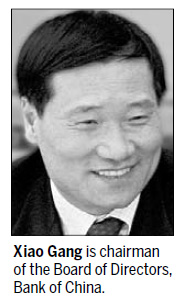Integrating financial Asia
Updated: 2011-12-16 15:51
By Xiao Gang (China Daily)
|
|||||||||
Region should improve policy consultation and strengthen regulatory capabilities to promote an economic community
It is encouraging that the Association of Southeast Asian Nations (ASEAN) is progressing on an ambitious plan to build up an integrated economic community by 2015. This community will include a free trade and investment market, a common visa regime for professional workers and the liberalization of capital flows. I believe that regional financial cooperation and integration are crucial to how effectively the plan will be implemented.
|
 |
With its population of 620 million and gross domestic product of $1,800 billion forecast for this year, ASEAN has achieved an average annual GDP growth of 6-7 percent over the last decade, becoming one of the world's most dynamic economic regions. However, financial cooperation in this region lags well behind trade and economic development.
According to an international capital survey by the International Monetary Fund, foreign direct investment attracted by Asia and outbound investment from Asia have been rapidly growing since the Asian financial crisis of 1997-98, but the cross-border investment within Asia is quite small, for example, outbound investments from ASEAN+3 (China, Japan and South Korea) accounts for just 3.9 percent of their total GDP, well below the ratios in the United States and the European Union.
In terms of cross-border credit, countries in Asia are more reliant on borrowing funds from outside the region. Meanwhile, given many limits imposed on the Asian bond markets and higher transactional costs and inefficiencies, investors from the US and the Europe prefer to pursue equity investment, rather than bond investments.
What's more, the interconnectedness of prices on monetary markets and debt markets within Asia, such as the yield curves of the certificated deposits, interbank borrowing and treasuries, are mixed and mismatched, indicating the degree of financial integration within the region is quite low and making it inconvenient for investors to boost their investment. The regulatory environment and weak market infrastructure are still barriers on the road to financial integration.
One of the key steps for integrating financial Asia should be to further strengthen the region's monetary cooperation mechanism. Based on the Chiang Mai Initiative signed by ASEAN+3 in 2000, there is a need to explore how to maintain the region's relatively stable foreign exchange rate fluctuation in order to address the challenges of hot money flows and the US dollar's depreciation.
With about $6 trillion of foreign exchange reserve held by Asia, it is necessary to develop the off-shore US dollar bond market, making it possible for more companies, including multinational ones operating in Asia for a long time, to raise funds, and for more public and private investors to invest. In doing so, financial products and services must be innovated, improving the market's liquidity conditions, making full use of the region's funds to support the real economy and to strengthen the construction of infrastructure.
Deepening local currency bond markets could be an important reform for the region's financial industry. These markets can actually contribute to keeping savings at home, making it easier for enterprises to access finance rather than invest primarily in equity and real estate property markets. At the same time, they can broaden the spectrum of international investors and facilitate the diversification of investments, helping dampen the volatility of international capital flows in the region.
By the end of March 2011, the local currency bond markets' debt outstanding in emerging market economies amounted to $9.2 trillion (with Asian emerging markets accounting for two-thirds), more than twice the amount of March 2006 (before the global financial crisis). It can be expected in Asia that there will be more potential and dynamic growth.
As the giants of East Asia, China, Japan and South Korea should play an active part in Asian financial integration. The three countries should not only speed up the process of finalizing a trilateral free-trade agreement, but also pay more attention to financial policy consultation and monetary cooperation, allowing international trade settlement between the countries with local currencies.
Admittedly, Asian countries are at very different stages of development, therefore, the economic unity and financial integration have a long way to go and face challenges. In order to mitigate the risks generated from the deregulation of the financial industry and markets, it is imperative for Asia to strengthen financial security nets and regulatory capabilities.
Right now, Asia is facing the threat of a sharp withdrawal of credit from the Europe. Data from the Bank for International Settlements show that continental European banks hold 21 percent of the $2,520 billion of international bank loans outstanding in Asia excluding Japan as of the end of June 2011. Many Asian nations depend on foreign banks for a large amount of funding to support their domestic growth, so the possible reduction in credit availability as a result of the European crisis needs to be carefully managed by policymakers in Asia.
Asian economic and financial integration will be open and beneficial to the world. The more open the Asian markets become, the more powerful an engine Asia will be for driving the world economy. The US has acquired a huge benefit from Asia through trade, investment, tourists, international students and immigration, and will do so in the future.
It is true of course, that there are several international platforms and mechanisms in the Asia-Pacific region, such as the Asia-Pacific Economic Cooperation, the ASEAN+3, the Trans-Pacific Partnership and the East Asia Summit. The re-engagement of the US in Asia makes the situation more complex and sensitive.
It is not really important who leads the process of regional integration. The most important thing is simply how many cooperative opportunities and achievements in the economic and financial integration can realized.
Asian countries are politically and economically diverse, yet the economic ties among them lay a solid foundation for politics. The world is changing rapidly and any hegemony in international affairs could be, to some extent, more reflected in financial markets than in simple state power.











